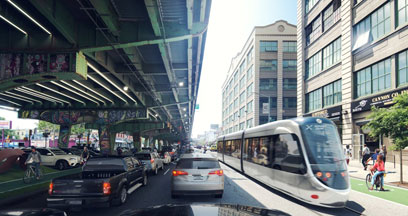He’s not playing fare!
A Sunset Park councilman with a long history of trashing Mayor Bill de Blasio’s multi-billion-dollar pet trolley project — the Brooklyn-Queens Connector — is now vying to leverage a public review of the controversial transit scheme to bring express bus service to his constituents.
“I think that it is a mistake that Sunset Park isn’t part of this conversation,” said Carlos Menchaca at the first city Council hearing to discuss the trolley project at City Hall on May 30.
As part of a public review of hizzoner’s $2.73 billion trolley proposal, the city’s Economic Development Corporation has commissioned a study kicking off this fall, called an Environmental Impact Statement, that will include an analysis comparing hizzoner’s hugely expensive trolley scheme versus the city’s less flashy, but far cheaper Select Bus Service, which makes express stops and includes other features designed to decrease travel times, according to the executive vice president of the city-run corp.
“We found with an apples-to-apples comparison that you only see a capital costs saving of 30 percent by doing [bus rapid transit] versus light rail or streetcar,” said Seth Myers, casually down playing an estimated $800 million in taxpayer savings at Thursday’s Council hearing.
And Menchaca — who chairs a five-member BQX task force providing Council oversight of de Blasio’s rail scheme — says he wants in, and is calling on officials to use the trolley study as an opportunity to bring Select Bus Service to his scorned constituents.
Myers, however, was reluctant to oblige the Sunset Park lawmaker, and said the neighborhood should explore more orthodox solutions for enhancing local transit, directing the councilman to petition the Department of Transportation.
“Using an EIS process for the BQX may not be right forum to have that conversation,” the honcho said.
The mayor’s trolley scheme originally snaked through transit-starved coastal neighborhoods along a 14-mile route between Queens and Sunset Park, but the high cost of spanning the Gowanus Canal, coupled with low-ridership projections on the other side of Brooklyn’s Nautical Purgatory, led officials to shorten the route by three miles, ending it in Red Hook, Myers explained.
“It required the crossing of the Gowanus and a bridge of several hundred million dollars to get the train there and then it was a several mile run that really didn’t attract the level of ridership that seemed to justify that cost and that potential disruption of local businesses,” said Myers at the hearing.
But even before the trolley’s Sunset Park stops got the ax, Menchaca came out strong against the mayor’s streetcar scheme, saying rents would skyrocket and locals would be displaced along its trajectory.
Indeed, the EDC’s early projections forecast that increased tax revenue generated by higher property values along the line could fully fund the proposed tram, although the city now admits that increased property taxes will only cover half the costs.
Their new plan is to lean on Uncle Sam for the remaining funds, although some members of the trolley task force took the city’s claim that the Trump administration would be willing to shell out some $1.3 billion for a city transit project with a grain of salt.
“The current occupant [of the White House] is not necessarily the most friendly to New York City,” said Councilman Jimmy Van Bramer (D–Queens).
Van Bramer echoes sentiments of federal Brooklyn pols, who said the mayor shouldn’t hold his breath for a Washington windfall.
The agency aims to start the city’s Uniform Land Use Review Procedure next year, and officials set a start date for construction at 2024 with the hope to get the service up and running by 2029, according to a spokeswoman.
























